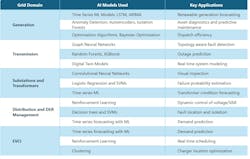How AI Is Reinventing the Grid, One Algorithm at a Time
Key Highlights
- AI improves renewable energy forecasting accuracy by up to 33%, helping grid operators better integrate solar and wind resources.
- Predictive maintenance powered by AI reduces equipment downtime by over 30%, enhancing reliability and reducing operational costs.
- Drones and computer vision are used for autonomous inspection of lines and substations, speeding up hazard detection and maintenance planning.
- Digital twins and AI-driven simulations enable rapid scenario analysis, supporting grid stability amid increasing renewable and EV loads.
- AI enhances EV charging management, enabling utilities to optimize demand response and defer costly infrastructure upgrades.
The electric grid is undergoing a digital transformation, and at the heart of it is artificial intelligence (AI). Today’s utilities are moving beyond theoretical AI-talk and building real systems that help operators forecast renewables, detect equipment problems before they cause outages, automate complex planning tasks, and even optimize EV charging. In generation, transmission, distribution and the growing EV charging infrastructure, AI is being applied to concrete problems, some already in commercial use, others still in pilot or R&D.
AI in Generation
Utilities and grid operators are using AI/ML to improve generation planning, especially for intermittent renewable energy technologies. A key use case is in solar and wind forecasting. For example, the UK’s National Grid ESO partnered with the non-profit Open Climate Fix to apply deep learning to satellite imagery for “nowcasting” solar output on a minute-to-minute basis. This AI-powered forecasting outperforms conventional models (E.g. transformer-based models proved ~3× more accurate than legacy forecasts) and has already improved National Grid’s solar forecast accuracy by ~33%. DOE research identifies “advanced AI to forecast renewable energy production for grid operators” as a high‐value opportunity.
AI is also used for generation asset management. For instance, PG&E reports using Atomic Canyon’s generative AI to train staff on nuclear plant procedures at Diablo Canyon. In planning generation, utilities like Southern California Edison are using AI to optimize power flow and generation dispatch within the existing network, deferring costly new lines. Additionally, Xcel Energy partnered with NVIDIA to run AI models for wind forecasting, helping balance intermittent resources with grid demand. Duke Energy uses deep learning models to monitor gas turbine sensors, enabling predictive maintenance that’s reduced downtime by over 30%.
AI in Transmission and Substations
On the high-voltage side, AI is helping utilities manage lines and substations more intelligently. Utilities are experimenting with AI vision systems on drones or towers to detect line clearance issues. For instance, NVIDIA reports a pilot where Noteworthy AI used AI models on imagery of FirstEnergy’s poles and found vegetation encroachment (a wildfire risk) with an order-of-magnitude speedup. SCE has teamed up with NVIDIA on an “Intelligent Grid” collaboration to apply AI for asset and vegetation inspections. The idea is to use computer vision and edge AI (e.g. NVIDIA Jetson modules) on drones or fixed cameras to autonomously scan equipment for defects or hazards. These pilots are rapidly moving toward operational use: SCE expects demonstration projects of AI inspection and power-flow simulation tools within a year.
AI also assists in real-time monitoring and control. For example, PG&E has deployed thousands of AI/ML-enabled sensors and cameras in its grid for wildfire situational awareness. They operate over 650 high-definition cameras whose images are analyzed by AI algorithms to automatically detect smoke or sparks, triggering faster response.
In grid planning and outage management, AI-driven simulation is taking hold. EPRI is collaborating with NVIDIA on AI-accelerated digital twins of the transmission network. Unlike traditional power-flow models, these digital twins can simulate millions of scenarios quickly, for example, automatically evaluating the impact of new rooftop solar or EV loads on grid stability.
AI in Distribution and Transformers
Real-time data analytics are improving distribution operations too. Software platforms like Utilidata’s Karman use AI embedded in smart meters to analyze sub-second voltage and current data. In a field trial with University of Michigan, Karman running on NVIDIA edge chips identified individual EV chargers behind meter data and demonstrated it could instantly react to stabilize EV-induced voltage fluctuations on a feeder. Likewise, on customer analytics, utilities are using AI-based “load disaggregation” to understand behind-the-meter usage. Avista Utilities, for example, applied Bidgely’s AI software on AMI data and reduced high-bill customer service calls by 27%, the AI pinpointed which appliances were driving unusual usage, so crews didn’t have to chase phantom meter faults.
Distribution transformers and substations are also seeing AI-driven condition monitoring. Programs (some commercial, some R&D) attach thermal, acoustic, and dissolved-gas sensors to transformers and use machine learning to detect early signs of insulation failure. GE Vernova and Systems With Intelligence are developing products that merge infrared cameras with transformer DGA analyzers to predict faults (first demo expected in 2025). Utilities are piloting these with commercially available tools to shift from preventive to predictive maintenance.
AI in EV Charging Infrastructure
Electric vehicle charging is a special case of “grid edge” where AI is already getting practical attention. Utilities are under pressure to integrate large numbers of EVs without overloading local feeders. NV Energy used Bidgely’s AI to identify EV-owning customers and enroll them in managed-charging programs, boosting per-vehicle load shifts to 2–4 kW versus 0.2–0.8 kW without AI roughly 2.5–10× improvement. Similarly, Ameren Missouri analyzed 10,000 customer meters with AI to find just 73 with significant unmanaged EV charging; by steering those drivers to off-peak charging, the utility deferred costly line upgrades. Even outside the U.S., Canadian Hydro One applied AI on smart meter data to spot ~20,000 EVs – ten times more than were self-reported helping it plan charging infrastructure more accurately.
On the customer side, utilities offer AI-driven apps that give EV owners charging insights. For example, NV Energy partnered on a smart-phone app that uses ML to detect which vehicles are charging, showing users when to charge or discharge (vehicle-to-grid) to maximize savings. These apps are not just pilots: NV’s EV-charging portal now uses AI-based load forecasting to schedule demand response events in real time. In sum, EV charging is where AI’s business case is becoming concrete – utilities see immediate ROI in avoided capital costs and improved demand management, so these systems are moving quickly from pilot into operational use.
Commercial Deployments vs Research Pilots
It is important to distinguish what is operational today versus what remains experimental. Many utility AI applications are still in pilot phases, often under R&D consortia or vendor collaborations, such as SCE’s NVIDIA partnership or open AI-for-Utilities testbeds. At the same time, several use cases are already commercialized: PG&E’s wildfire-safety AI, EV load disaggregation at NV Energy and Avista, and AI-enhanced forecasting now embedded in system operator tools.
A recent MIT study found that 95% of generative AI pilot projects across industries fail to show measurable returns. The root causes, however, lie not in the technology itself but in poor workflow integration, unrealistic objectives, and lack of alignment with business needs. Utilities are somewhat distinct in this regard. Their AI initiatives typically target concrete, high-value operational challenges, like wildfire detection, renewable forecasting, or EV load management, where success metrics are well-defined and the payoff is tangible. That’s why, while many corporate AI pilots fizzle, grid-focused AI projects are increasingly crossing the chasm from pilot to production. The lesson is not that AI “fails,” but that its success hinges on domain-specific focus and operational grounding, qualities utilities are now embracing.
Periodic Table of AI in Power Grid
Conclusion
AI is no longer on the fringe of utility operations, it’s embedded in the field, in control rooms, and increasingly, in the planning layers of the grid. What distinguishes successful implementations today is their precision: utilities are applying domain-specific AI, trained on high-resolution operational data, to solve targeted challenges, not generic ones. Still, the spectrum of maturity varies. Camera-based inspections, EV detection, and AI forecasts are entering production, while AI-powered grid simulations and digital twins remain in R&D or pilot stages. The scale of this shift is not just anecdotal but measurable. Fully deploying today’s AI tools has been shown to unlock up to $110 billion annually in cost savings for the global electricity sector. At the technical level, AI has delivered grid management calculations up to 12 times faster than traditional methods, strengthening both stability and efficiency. In renewables, advanced models are cutting forecasting errors for solar and wind by nearly 30%, enhancing the reliability of variable generation.
These figures, combining economic savings, exponential improvements in computational speed, and sharper forecasting accuracy, are the metrics of a paradigm shift. They point to an energy grid that is becoming more resilient, predictive, and adaptive, with AI moving steadily from pilot projects into the core utility workflow.
About the Author
Komal Ishaq
Komal Ishaq is a Consultant at Power Technology Research (PTR), where she contributes to advanced research and analysis in the global power sector. With a Master’s degree in Energy Systems from Northeastern University, Komal brings a strong interdisciplinary background spanning AI applications in energy, renewable integration, and power system planning. Her professional experience includes consulting for organizations like The World Bank and ICF, where she worked on resilient infrastructure planning, system adequacy modeling, and emerging energy technologies. She is passionate about leveraging data-driven insights to enable sustainable, resilient, and future-ready energy systems.

